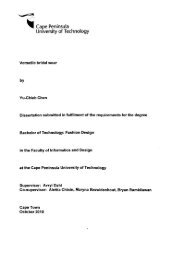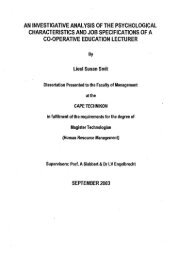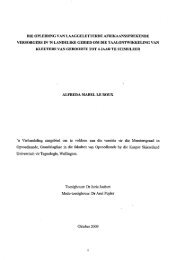E-commerce - Cape Peninsula University of Technology
E-commerce - Cape Peninsula University of Technology
E-commerce - Cape Peninsula University of Technology
You also want an ePaper? Increase the reach of your titles
YUMPU automatically turns print PDFs into web optimized ePapers that Google loves.
Chapter 2: Uterature review Page 33<br />
associated with Internet shopping, ranging from confusing information, long<br />
upload sessions, and payment difficulty (Ryan & Valverde, 2003). Internet<br />
holiday shoppers have also reported myriad problems including late delivery,<br />
paying extra shipping costs for products to arrive on time, receiving partial<br />
orders, and receiving damaged merchandise (Zemke & Connellan, 2001).<br />
Despite the recognition <strong>of</strong> the fact the service problems are relatively<br />
widespread in the e-<strong>commerce</strong> sector to date, research on service failure and<br />
recovery issues has focused almost exclusively on failure and recovery in the<br />
context <strong>of</strong> interpersonal service encounters. That is, service situations in<br />
which the service customer and provider interact with each other in order to<br />
consummate the service transaction (Smith & Bolton, 2002).<br />
To comprehend the impact <strong>of</strong> customer disappointment, it is important to<br />
know what consumers consider to be bad experiences and how those<br />
experiences will impact in their future actions. When experienced shoppers<br />
were asked which barriers, if any, might prevent them from making more<br />
online purchases in the near future, the need to touch, feel, and try on<br />
products was the most common response as shown in figure 2.3 (see<br />
questionnaire analysis: Appendix C). Internet retailers choosing to carry high<br />
involvement products will continue to struggle with the consumer's need to<br />
experience these types <strong>of</strong> products in future years (Windham & Orton, 2000).<br />
Windham and Orton (2000) further illustrates that these high-involvement<br />
retailers should seek ways to provide target customers with the required<br />
tactile information to overcome the barriers to the sale. Whether addressed<br />
through the use <strong>of</strong> better graphics technology and higher bandwidth or<br />
through, multichannel alternatives, the issue must be addressed to break<br />
through current barriers.
















